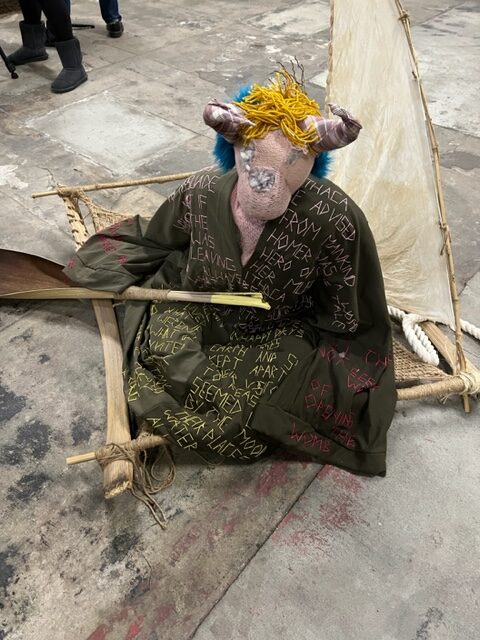Serving as a truly beautiful adjunct to the Catalina Museum for Art and History’s permanent collection, now through September 3rd, visitors to Catalina Island can enjoy the transporting exhibition Tall Tiki Tales. Curated by author, tiki scholar, and cinematographer Sven Kirsten, the widely encompassing show includes artifacts from films shot on the island, dining spots, and resorts, as well as and original books and artwork that enhance the understanding of a cultural phenomenae that shaped tastes and traditions – as well as wildly fun beverages – both on and off Catalina.
Frequently serving as a film set that helped to popularize tiki as an art form, Catalina has a rich history in the development of America’s happy obsession with all things tiki, including the bars and restaurants that grew nationwide during the 1930s.
A highlight of the well-curated exhibition is an interactive one – visitors can sit down at a cozy table in a replica tiki bar to experience a unique design by master tiki bar designer Bamboo Ben. Viewers are transported to a blissful paradise with the sound of pattering rain upon sitting down. The only thing missing is a classic beverage.
According to Johnny Sampson, the museum’s Deputy Director and Chief Curator, Catalina Island served as a major film set for movie adaptations of works such as Nordhoff and Hall’s Bounty Trilogy and The Hurricane, W. Somerset Maugham’s short story “Rain” and The Ebb Tide by Robert Louis Stephenson. “Hollywood quickly adapted these and other stories into movies, using Catalina Island as an accessible backlot for far away South Seas locales…we had Christian’s Hut from the set of Mutiny on the Bounty, the Chi Chi Club at the Isthmus and in Avalon, Hotel Waikiki, and Hurricane Cove—which even had lighting effects and fans to recreate the thrill of Hurricane for its patrons.”
The fascinating mix of photographs, original art, and collector’s items – as well as the one-of-a-kind tiki hut immersive experience, beautifully support another look at the island’s past, a stellar permanent historical collection touching on other areas of Catalina life, including other film shoots, Chicago Cubs memorabilia, a wide ranging survey of Catalina pottery and tile, and a collection of photographs, negatives, and films documenting island life from the early 1880s to the present.
Viewers will also observe early phone switchboards, the evolution of transportation from the mainland, sport fishing items, and a wonderful collection of Tongva and Gabrielino artifacts. The fine art collection includes photography, plein air painting, contemporary sculpture, and examples of architectural and graphic design.
Combined with Tiki Tales, viewers will find an absolute treasure trove of art and history, as the museum continues to live up to its name with deep dives into island life and vibrant, intelligent art exhibitions.
And, if Tiki Tales made you thirsty or hungry, there’s a quick solution for that. Walk on down Crescent street to Luau Larry’s. The indoor thatched roof hut and bamboo walls and delightfully kitschy ocean-themed paintings and murals here are even joined by an historic tiki wood carving, hanging above the booth we choose to sit in, a happy coincidence.
We enjoyed vibrantly colored Polynesian- style cocktails – a bright Blue Hawaiian and the bar’s signature tiki drink, a Wiki Wacker with Cruzan aged light rum, Parrott brand, pineapple/orange juice and grenadine. The latter comes with imbibers’ choice of straw hat or bumper sticker. The food was fine too – fresh, savory popcorn scallops and shrimp, a well-seasoned, fresh poke, and a first-rate seared ahi platter served with ginger, wasabi, soy sauce, and a nicely sweet, crisp cole slaw.
Currently, the Catalina Island Company is offering a terrific getaway – the Tall Tiki Tales package, that combines a hotel stay at the beautifully updated Hotel Atwater and a boat ride to Catalina – we had the pleasure of traveling from Long Beach via Catalina Express, a safe, swift, and beautiful passage across the blue Pacific, arriving with a great view of the historic Casino building upon arrival in Avalon Harbor. We experienced the journey two ways – indoors in the comfortable Commodore Lounge, replete with a glass of Brut Chandon, and outdoors, with the wind whipping our hair and an eye trained on pelicans on a long flight.
In an upcoming article, our stay at the Hotel Atwater, a look at the in-depth Behind the Scenes casino tour, and additional dining experiences. For now, go experience a few Tiki Tales at the Catalina Museum for Art and History – and then raise a toast to the exhibition at Luau Larry’s.
- Genie Davis; photos by Genie Davis and provided from the museum’s collection





























































































